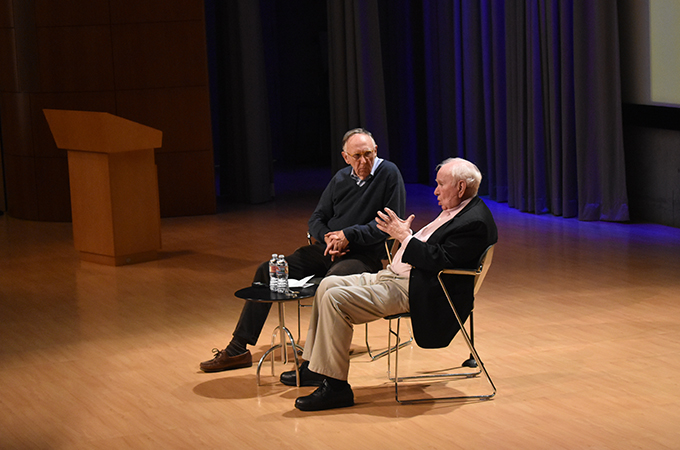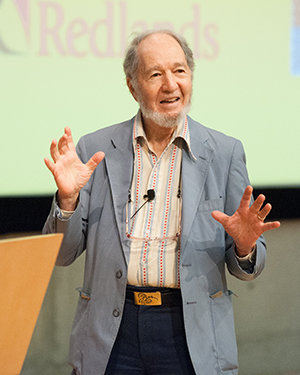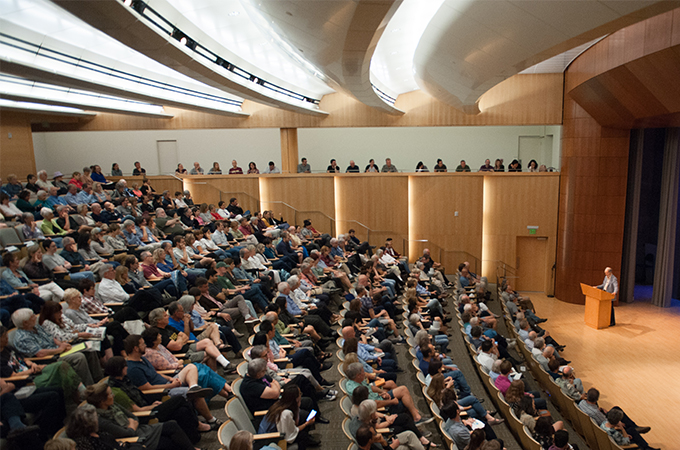Last week, community members gathered for two Redlands Forum events to learn about how certain aspects of history, culture, and geography have influenced modern life. Peter Raven, one of the world’s leading scientists, explored biology and climate, while Jared Diamond, a Pulitzer-prize-winning author, provided an in-depth look at how geography influenced the rise of civilization.
The Redlands Forum—celebrating its 10th anniversary this month—is an educational and cultural series jointly sponsored by Esri and the University of Redlands Town & Gown.
“The talks by Peter Raven and Jared Diamond were thought-provoking,” said Char Burgess, vice president for external affairs and dean emerita. “They represent the incredibly high caliber of conversation we've had over the past decade in the Redlands Forum."
A call to action
Raven, who for four decades headed the Missouri Botanical Garden, is a champion of research to preserve endangered plants and is a leading advocate for conservation and sustainability.
Speaking only a few days after climate strikes occurred around the globe, Raven joined Esri Co-founder and President Jack Dangermond for a conversation about biodiversity and the future of the planet. Focusing on the invention of agriculture, he illustrated how it led to a population boom because people were able to bypass unfavorable seasons instead of hunting and gathering.
What people don’t realize, Raven said, is that this change in technology that occurred thousands of years ago is still affecting us today. “We’re using 175 percent of our available resources,” he said. “What happens when you use more money than you have in the bank? You go bankrupt.”
Raven calls this impending bankruptcy “the crash,” referring to an era of widespread starvation and ecological collapse. According to Raven, this event is inevitable, because the climate and biodiversity—both necessary to maintain a healthy environment—are each in crisis.

So, Dangermond asked him, what’s next? Raven said it’s up to us to combat these crises and offered the audience a few pointers for taking action. These included: living close to work, eating a plant-rich diet, voting for representatives with platforms that prioritize the environment, talking to children about sustainability, and showing them different parts of the world.
“Global warming is not some hypothetical thing,” said Raven. “If you don’t care about the future of the climate, you’re living in a total illusion.”
Agriculture and the New World
The following evening, author Jared Diamond, a professor at University of California, Los Angeles, examined fundamental questions of why civilization evolved differently in various parts of the world. “Geography is the bedrock of society,” he said in beginning his talk.
Drawing on concepts from his 2005 book, Collapse: How Societies Choose to Fail or Succeed, Diamond revealed that differences in population density, simple technology, and social structure of hunter-gatherer populations allowed certain geographical areas to explode, socially and culturally, with the advent of farming. Agriculture arose in Iraq, China, Ethiopia, Nigeria, Mexico, Peru, and the southeastern United States because those areas were conducive to domesticating wild plant and animal species, not because they had the best farmland.

Diamond, who is also a director of the international environmental organizations World Wildlife Fund and Conservation International, noted that only 14 animal species have been successfully domesticated—one in the Old World and 13 in the New World. In order to be domesticated, species must be easy to feed, able to breed in captivity, quick to mature, and easily contained, as well as observing a follow-the-leader social structure.
Following the domestication of farm animals, diseases began to spread through the dense populations that surrounded agricultural epicenters. Only the populations that had the resources to combat disease survived, eventually leading to the creation of the New World.
“These geographical factors contributed to the European expansion and the world we live in today,” said Diamond.
While Diamond explained his theories with ease, he added that there are still more questions to be answered—perhaps, he joked, in his next book.
Past Redlands Forums have featured speakers including historian Ed Ayers, activist Ralph Nader, biologist Jane Goodall, The Atlantic editor and correspondent Jim Fallows, former Governor of Arizona and former U.S. Secretary of the Interior Bruce Babbitt, and other thought leaders.
Next up in the Redlands Forum is "Finish Strong—Choices as Life Ends" by Samantha Trad, California state director of compassion and choices. Registration, which opens one week prior to the talk, is required. For more information, see the Redlands Forum website.






